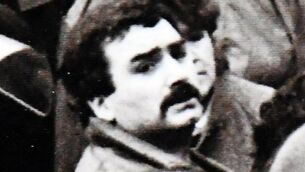Patients benefit from revolution in cancer care
Before patients did not hear of all the treatment options. The changes that have taken place are of enormous benefit
TEN years ago, Dr Paul Kelly spent a year in Cork University Hospital as an intern.
Last summer, he returned from the Dana Farber Cancer Institute in Boston to take up a permanent post at CUH as a consultant radiation oncologist. He was blown away at how cancer care at CUH had changed — for the better.
“The difference between when I was at CUH last and now is incredible, really incredible. The place has really been revolutionised.”
Dr Kelly did his fellowship at the Harvard medical school affiliate hospital and said “the gap” between the two (Dana Farber is widely seen as one of the world’s leading cancer centres) is much more narrow these days.
“Six years ago, there were two radiation oncologists at CUH. Soon there will be seven — and each of the seven all have their side speciality. Before in oncology in Cork, you treated all the cancers. Also, 10 years ago there wasn’t a multidisciplinary team. But now all diagnoses are now made at that forum and the best treatment pathways decided. Before, often as a patient, you didn’t hear of all the treatment options that were available to you. The changes that have taken place are of enormous benefit.”
Few will challenge him on this. It’s universally acknowledged that gargantuan change has taken place in this country since 2006 when the national cancer strategy recommended that Irish cancer care be centralised to eight specialist cancer centres.
As one of those eight designated centres, up to €5m was spent by the National Cancer Control Programme (NCCP) on developing a rapid access centre at CUH which presently treats patients suspected of having breast, lung or colorectal cancers. GPs from Cork, Kerry, South Tipperary, West Waterford, and South-East Limerick all send patients to the Cork Cancer Centre.
From this summer, prostate cancer will also be treated at CUH as the existing prostate service at the Mercy University Hospital is due to relocate.
Since CUH was designated a regional cancer centre, at least 16 new staff appointments have been made including surgeons, physicians, radiologists, nurse specialists and pathologists. Patients now have access to a full pathway of care at one site including surgery, radiology, pathology, radiation and medical oncology and palliative care. Much training has also been completed with GPs to make them more aware of early indicators of the various cancers.
Next June for the first time, the CUH Cancer Centre will also begin providing brachytherapy to people with prostate cancer. Brachytherapy is a type of cancer treatment where radioactive seeds are put into the gland. Unlike radiotherapy, which takes place over eight weeks, this is a one-off and has minimal side effects, perhaps urinary irritation and that’s it.
Dr Kelly is delighted with the advance. “Each year, we send about 30 or 40 patients to Dublin and Galway for such treatment so it will be great to have it here.”
There are also plans for a further upgrade to CUH’s radiotherapy equipment with the development of intensity modulated radiotherapy.
This is a more precise form of radiotherapy and is due to begin at CUH late this year. It allows for the radiation dose to conform more precisely to the 3D shape of the tumour. It also allows higher radiation doses to be focused to regions within the tumour while minimising dosage to surrounding body parts.
“All of these advances are bringing us into line with the best hospitals worldwide. Informed patients were asking for these treatment options and were travelling for them but it is great that they will now be available here,” said Dr Kelly. Up to €1.5m of NCCP and €500,000 of Aid Cancer Treatment funding was used to buy the vital equipment.
WALKING through the corridors of the centre, you can visibly see the investment in cancer services that the NCCP facilitated.
There isn’t a hint of the shabbiness that we sadly have come to expect in public hospitals. Instead there is a brightness to the corridors and all the fixtures and fittings are new. The corridors and internal rooms are painted purple/pink and there are colour photographs hung everywhere, all taken by Eugene O’Sullivan, who works in the hospital’s medical physics unit.
It’s the diagnosis, or ‘quiet’ rooms, however, that really bring home how far our thinking around cancer has come. They’re more living room than waiting room, with comfy leather sofas and candy striped armchairs.
Clinical co-ordinator for cancer services, Antoinette Cotter, said funding for the interior design came from Aid Cancer Treatment, which raised €25,000 for the project. Every year, it raises €150,000 to €200,000 for the hospital. Since 1983, it has raised €7m for cancer care.
All the consultants working at the Cork Cancer Centre wax lyrical about the work of the NCCP. Initially headed by the formidable Professor Tom Keane, its director since 2010 is the equally focussed Dr Susan Reilly.
Cork University Hospital has also been chosen as part of the national network for radiation oncology services. In recent weeks, such radiation oncology facilities were opened at a cost of €60m at St James’s and Beaumont hospitals in Dublin.
According to the HSE, over the next five years, up to €175m will be spent on the development of the radiation oncology services at Cork and Galway — along with continued phased development of the centres in Dublin. CUH’s new radiation oncology unit, which will have world-class equipment including the most advanced linear accelerators, is to be developed at the site currently housing the hospital’s psychiatric wing.
The investment in cancer services can also be felt in GP surgeries. There is now a much clearer diagnosis and treatment route for anyone who could potentially have cancer. All GPs have standardised referral forms that they send to the centre and HIQA key performance indicators set out deadlines within which patients must be seen for tests.
Urgent potential breast cancers must be seen at the rapid access clinics within 10 days, early referrals must be seen within six weeks while routine, or people presenting because of family history, must be seen within 12 weeks.
Four breast clinics are held each week at CUH, two colorectal clinics, one lung cancer and one prostate clinic. All the referral forms for the various cancers all come into the Cancer Control Office at CUH and must be stamped on the day they arrive so that no time is lost in meeting KPI deadlines. Diagnosis and treatment isn’t signed off on until the weekly multidisciplinary meeting where radiation oncologists, surgeons, radiologists, pathologists, radiographers and nurse specialists gather to examine all recent lab results.
“To be honest, patients can’t get over the quality of the service when they come in here. And the staff are delighted too,” said Adrienne Cotter.
But what about the staff who were forced to move from the South Infirmary, Kerry General, and Mercy University Hospitals because of the centralisation of cancer services? “All the hospitals have amalgamated quite well. The staff can all see the difference the cancer centre has made to the quality of patient care,” she said.
Consultant respiratory physician Mike Henry is more blunt: “The NCCP is the best thing that ever happened to cancer in Ireland. It gave us resources, allowing us to overrule the public sector recruitment moratorium. There may have been a lot of unease about moving sites but staff from the other hospitals, including the South Infirmary, are all firm supporters of it now as they can see the figures which are fantastic.”
He points to CUH statistics which show that over the past six years, surgical resection rates for lung cancer have risen from 9% to about 25%.
All potential lung cancer patients are seen at the cancer centre within 10 days with CT scans carried out first. Last year, a total of 177 lung cancers were diagnosed at CUH, 92 through the rapid access clinic and 85 from referrals from other parts of the hospital.
“Two out of three of the people that we see won’t have lung cancer but we have done a lot more information sessions with GPs as lung cancer was being picked up too late,” he said.
There is more work to be done, however, and Dr Henry says the cancer centre needs to strengthen its ties with the Cork Cancer Research Centre at the Mercy University Hospital. He would also like to see a professor of oncology appointed who could work between UCC and CUH.
PROFESSOR of surgery at the Cork Cancer Centre is Paul Redmond, the former chair of the National Cancer Forum.
His speciality is breast cancer and CUH has the busiest breast cancer clinic in the country, seeing 5,229 new patients last year. He says breast cancer care has become increasingly “evidence based” in this country and points to the benefits to patients of having access to triple assessment, comprising of a medical examination, a mammogram or ultrasound, and a needle biopsy. “Before they could have been waiting a couple of months for a mammogram alone as we just didn’t have the staff.”
All breast surgery and radiotherapy is now completed at CUH but patients from Kerry can still have their chemotherapy provided more locally. Follow up mammograms can also be completed in Kerry.
Prof Redmond sounds a note of caution, however, about the consolidation of all cancer services at CUH. While the NCCP has done wonders for cancer care, the cancer centre isn’t entirely cosseted from the attacks on the overall hospital budget.
CUH is feeling the pressure with bed closures mounting and trolley numbers rocketing at & the emergency department. Pancreatic and oesophageal cancer facilities were due to transfer from the Mercy but as of yet, they have remained in the city centre. According to CUH, the pancreatic cancer unit will move in July but a date isn’t set for oesophageal.
However, Prof Redmond won’t be putting pressure on management to close the MUH services.
“I think that in the current financial negotiating climate, we may have to stall on these transfers. There have been bed closures in Mallow, city hospitals and Bantry. Bed capacity is at a premium at CUH. I think that we will have to look at CUH operating a kind of virtual umbrella with the Mercy continuing with these cancers for the time being. Pancreatic cancers, in particular, are increasing and they are a very complex surgery. The Mercy is doing these cancers very well so why move them if they are being done safely as it is?”
It’s an argument that medics in many of other city hospitals vocalised when they saw well functioning units being dismantled and redeveloped in Wilton. However, it fell on deaf ears in the interests of improved patient outcomes, an argument that has been bolstered by recent HIQA figures.
In the case of cancer of the pancreas and cancer of the oesophagus, financial pressure at the wider Cork University Hospital complex might just give them breathing space.












